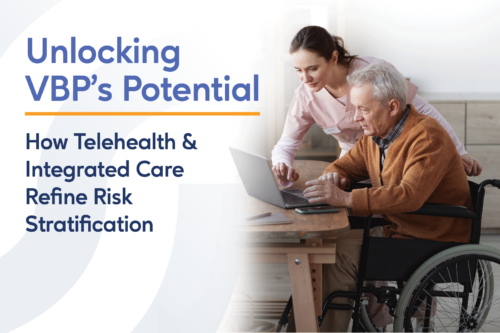Robust telehealth and integrated care refine home health risk stratification under VBP

Home Health Risk Stratification: The Key to VBP Success in 2024 and Beyond
Agencies are relying on telehealth and stronger integrated care approaches to refine and boost their risk stratification processes for home health patients under value-based care, according to the experts at SimiTree.
“One of the goals of the Value-Based Purchasing (HHVBP) Program is reducing healthcare costs, and agencies are using risk stratification processes to accomplish that,” said Charles Breznicky Jr., SimiTree’s Director of Clinical Consulting.
“Telehealth interventions, improved chronic disease management, and stronger integrated care approaches are three examples of opportunities for home health providers to reduce unnecessary emergency department use and hospital readmission,” he said.
Under an expanded HHVBP program in 2025, the Centers for Medicare and Medicaid Services (CMS) will hold home health agencies to a higher degree of financial accountability for acute care costs that it believes may not have been needed.
VBP and Risk Stratification: A Powerful Combination for Optimized Performance
Future payment adjustments under HHVBP will be based on calculations factoring in potentially preventable hospitalizations as part of the overall payment methodology. This change for the 2025 performance year was finalized last November in the Home Health Final Rule for CY 2024.
The upcoming change in payment adjustment methodology has prompted SimiTree experts to work with clients to implement new risk stratification processes throughout 2024 in preparation.
Breznicky said the goal is to help agencies head off any unnecessary acute care by identifying which patients may need closer clinical monitoring, more effective medication management, or better disease management understanding.
“Risk stratification is the overall term for all the techniques we use to categorize patients based on data that includes health status and history, unique clinical characteristics such as comorbidities, and many other risk factors which could lead to potentially avoidable and adverse health outcomes,” Breznicky said.
Chronic Disease Management in VBP: Identifying and Mitigating Risks
OASIS, Comorbidities, and Beyond: A Holistic Approach to Risk Stratification
With the right processes in place, agencies can better evaluate risks and manage care for chronic and complex medical conditions, Breznicky said.
Agencies typically look to OASIS scoring as an integral means of identifying patients at high risk and tend to focus more attention on patients with high-risk diagnoses such as CHF, COPD, UTIs, and wounds.
But Breznicky said secondary diagnoses and comorbidities also play a role in VBP success. An orthopedic patient with a diagnosis of diabetes may be at higher risk of infection, complications or slow healing from a surgical incision, for example.
Risk stratification also requires evaluating the ability of patients to safely medicate and make use of equipment such as nebulizers, inhalers, and pulse oximeters, Breznicky said. Does the patient lack the strength and dexterity to effectively use the equipment? Does the patient have the right number to call to report a malfunction?
Telehealth and Integrated Care: Supercharging Your Risk Stratification Strategy
Equipping Your Team for VBP Success: Communication, Coordination, and Red Flag Awareness
An integrated care approach is an important component for managing chronic conditions, Breznicky said. He recommends communicating risk factors to all team members so that there is coordination of treatment and patient education.
Integrated care should include all screenings, checkups, and monitoring, according to Breznicky.
“It’s important to communicate risk factors to all team members for at-risk patients, including those identified as having an increased risk of hospitalization,” he said. “And consider all personnel who may have an impact and influence outcomes.”
Home health aides and office staff – who may answer the phone when patients call with questions or to report symptoms – should be made aware of risks, and know how to identify red flags and respond appropriately. It is important to have processes in place to share information and coordinate care management. Read three ways EHR technology is changing home health and hospice.
Telehealth for High-Risk Patients: Building the Case for Reimbursement
VBP risk stratification and telehealth interventions
Telehealth is increasingly important to the overall management of high-risk home health patients, even though CMS does not yet reimburse home health providers for telehealth visits.
With new G codes now available for reporting unpaid telehealth visits, it’s only a matter of time until CMS does reimburse, Breznicky said. He encourages providers to be vigilant in making use of G codes and accurately capturing telehealth costs on annual cost reports to give CMS the data needed to make decisions about reimbursement amounts.
It’s also important to include telehealth interventions in the patient’s Plan of Care, showing how the telehealth visits support goals and interventions in place to meet specific patient needs and demonstrate that telehealth visits are not taking the place of regular visits. Learn more about home health telehealth and billing guidelines in our recent webinar.
SimiTree: Your Partner in VBP Risk Stratification Excellence
SimiTree helps agencies with risk stratification to ensure better patient outcomes and stronger performance scores under VBP. Our experienced clinical operations specialists work with agencies to implement processes that boost overall care quality, improve patient satisfaction and outcomes, and reduce the need for emergency care or hospitalization.
To learn more about the changes to VBP, please visit the CMS website. You can also contact SimiTree for more information about how we can help your agency prepare for the future. Our financial experts are also available to help agencies streamline their revenue cycle for optimized performance.
Use the form below to contact us today to ask your question about our VBP consulting or financial performance.
Learn more about SimiTree’s Value-Based Purchasing consulting: http://bit.ly/42svMdu
Watch free on-demand webinars on VBP: Value-Based Purchasing Webinar Series, Part 1: Claims-Based Measures on Vimeo

